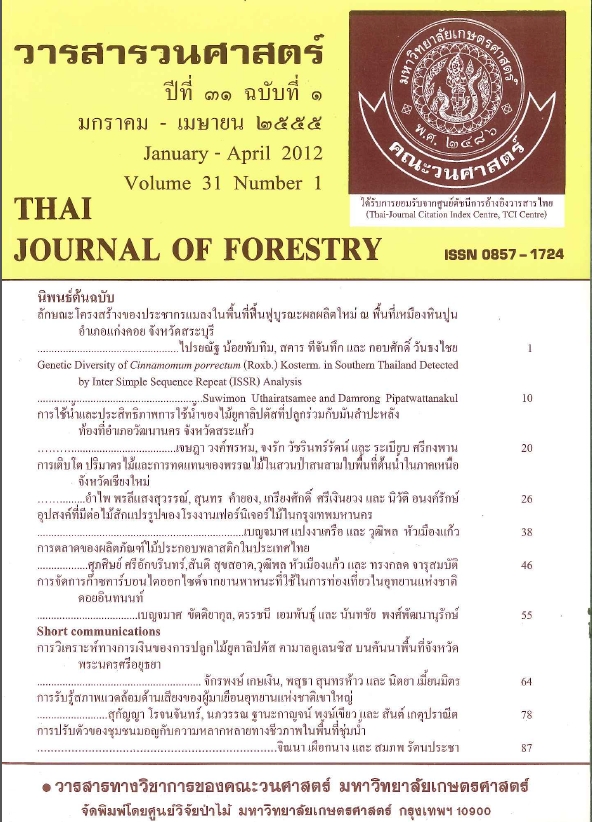การวิเคราะห์ทางการเงินของการปลูกไม้ยูคาลิปตัส คามาลดูเลนซิส บนคันนาพื้นที่จังหวัดพระนครศรีอยุธยา
Main Article Content
บทคัดย่อ
การศึกษาครั้งนี้มีวัตถุประสงค์เพื่อเปรียบเทียบผลตอบแทนทางการเงินของการปลูกไม้ ยูคาลิปตัส คามาลดูเลนซิส บนคันนา จำนวน 2 รูปแบบได้แก่ แบบแถวเดียวบนคันนา และแบบสองแถวสลับฟันปลา โดยแต่ละรูปแบบมีการปลูกต้นไม้ด้วย ระยะห่างระหว่างต้น 1 เมตร และ 1.5 เมตร ข้อมูลที่ต้องการได้มาจากการใช้แบบสอบถามที่สร้างขึ้นสัมภาษณ์เกษตรกรผู้ปลูกตัวอย่าง ซึ่งประกอบด้วยต้นทุนการปลูกข้าวและไม้ยูคาลิปตัสตั้งแต่ปีแรกจนถึงปีที่ครบรอบการตัดฟัน ผลผลิตข้าว ราคาข้าวและราคาไม้ยูคาลิปตัสรวมถึงการวัดขนาดเส้นผ่านศูนย์กลางเพียงอกและความสูงทั้งหมด ดังนั้นจึงสามารถคำนวณผลผลิตไม้ยูคาลิปตัสต่อพื้นที่นาข้าวหนึ่งไร่ในรูปของปริมาตรและน้ำหนัก และผลผลิตไม้ยูคาลิปตัส คามาดูเลนซิส หลักเกณฑ์ที่ใช้วิเคราะห์ผลตอบแทนทางการเงิน ได้แก่ การวิเคราะห์อัตราส่วนผลประโยชน์ต่อต้นทุน มูลค่าปัจจุบันสุทธิ และอัตราผลตอบแทนภายใน โดยกำหนดอัตราดอกเบี้ย 4 ระดับ คือ 6, 8, 10 และ 12 เปอร์เซ็นต์ ที่รอบตัดฟัน 3 ปี และ 4 ปี
ผลการศึกษาพบว่า การปลูกไม้ยูคาลิปตัส บนคันนาทั้ง 2 รูปแบบ มีความคุ้มค่ากับการลงทุน โดยการปลูกแบบสองแถวสลับฟันปลา ที่ระยะห่างระหว่างต้น 1 เมตร ที่รอบตัดฟัน 3 ปี อัตราดอกเบี้ยร้อยละ 8 จะได้ผลตอบแทนทางการเงินสูงสุด โดยมีค่าอัตราส่วนผลได้ต่อต้นทุน (B/C Ratio) เท่ากับ 1.70 มูลค่าปัจจุบันสุทธิ (NPV) เท่ากับ 7,724.91 บาทต่อไร่ และอัตราผลตอบแทนภายใน (IRR) เท่ากับร้อยละ 9.42
คำสำคัญ: ยูคาลิปตัส คามาลดูเลนซิส ผลตอบแทนทางการเงิน คันนา
Downloads
Article Details

อนุญาตภายใต้เงื่อนไข Creative Commons Attribution-NonCommercial-NoDerivatives 4.0 International License.
ข้าพเจ้าและผู้เขียนร่วม (ถ้ามี) ขอรับรองว่า ต้นฉบับที่เสนอมานี้ยังไม่เคยได้รับการตีพิมพ์และไม่ได้อยู่ในระหว่างกระบวนการพิจารณาตีพิมพ์ลงในวารสารหรือสิ่งตีพิมพ์อื่นใด ข้าพเจ้าและผู้เขียนร่วม (ถ้ามี) ยอมรับหลักเกณฑ์และเงื่อนไขการพิจารณาต้นฉบับ ทั้งยินยอมให้กองบรรณาธิการมีสิทธิ์พิจารณาและตรวจแก้ต้นฉบับได้ตามที่เห็นสมควร พร้อมนี้ขอมอบลิขสิทธิ์ผลงานที่ได้รับการตีพิมพ์ให้แก่วารสารวนศาสตร์ คณะวนศาสตร์ มหาวิทยาลัยเกษตรศาสตร์ กรณีมีการฟ้องร้องเรื่องการละเมิดลิขสิทธิ์เกี่ยวกับภาพ กราฟ ข้อความส่วนใดส่วนหนึ่ง หรือ ข้อคิดเห็นที่ปรากฏในผลงาน ให้เป็นความรับผิดชอบของข้าพเจ้าและผู้เขียนร่วม (ถ้ามี) แต่เพียงฝ่ายเดียว และหากข้าพเจ้าและผู้เขียนร่วม (ถ้ามี) ประสงค์ถอนบทความในระหว่างกระบวนการพิจารณาของทางวารสาร ข้าพเจ้าและผู้เขียนร่วม (ถ้ามี) ยินดีรับผิดชอบค่าใช้จ่ายทั้งหมดที่เกิดขึ้นในกระบวนการพิจารณาบทความนั้น”


